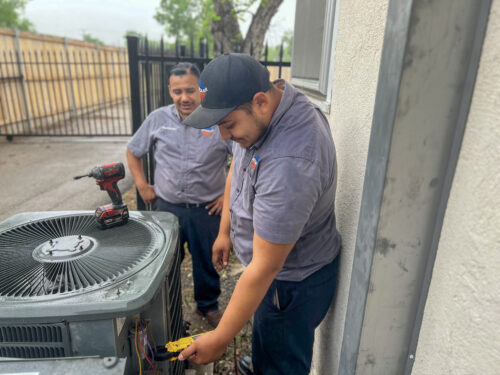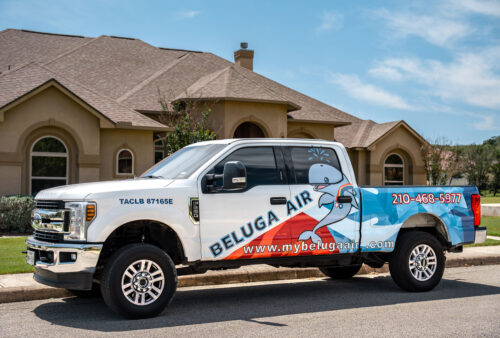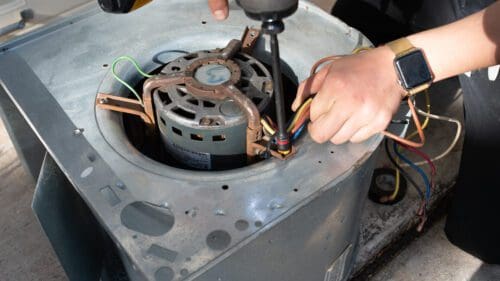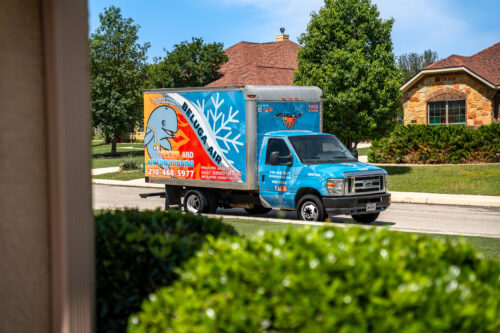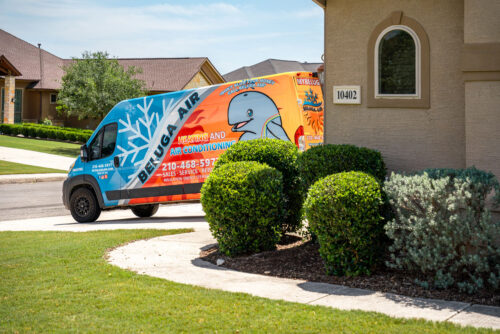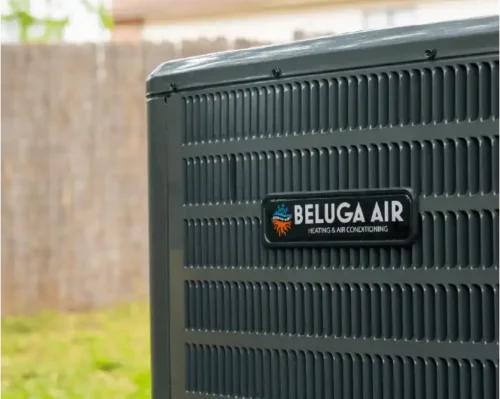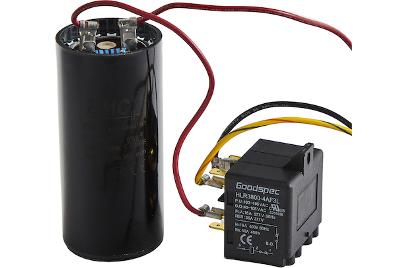8 Most Common HVAC Problems
Do you know how to spot and fix common HVAC problems before they become major issues?
The condition and proper functioning of your HVAC system is crucial in preventing major repairs. In fact, the US Department of Energy estimates that almost half of all system failures are due to lack of maintenance.
Common HVAC issues such as leaks, clogged drain lines, low refrigerant levels, dirty air filters, frozen evaporator coils, and incorrect installation can be easy to diagnose and fix before they lead to water leakage.
In this article, we’ll discuss the various HVAC issues and how to identify, fix, and prevent them. We’ll also discuss the benefits of preventive maintenance and inspections for your HVAC system and how to find trusted AC repair professionals.
So let’s dive in and get started!
Freon Leaks
One of the most common causes of an air conditioning or heating malfunction is leaky freon. Freon is a refrigerant that helps keep your system operating at an efficient level and ensuring proper cooling of your environment. It is important to regularly inspect the seals, valves, and tanks to ensure there are no leaks present. If a freon leak is spotted in your HVAC system, it should be fixed immediately. The following outlines the process for fixing a freon leak:
First, you will need to locate the source of the leak. This can be done with a pressure gauge, which will help identify any areas where the pressure has dropped too low. If there is a drop in pressure anywhere in the system, then it could indicate that there is a hole or crack somewhere in one of the pipes or components. It can also indicate that there might be a faulty valve or connection point that needs to be fixed.
Once you have identified where the leak is occurring, you will need to take steps to repair it. The most common way to fix a freon leak is by using a sealant specifically designed for this purpose. Depending on the size and location of the leak, you may need to use more than one sealant to make sure that it’s properly sealed shut. Make sure to follow any manufacturer instructions on how long you should wait for each sealant before proceeding onto the next step.
After all of the sealants have been applied, you will need to recharge your HVAC system with fresh freon — either by adding new refrigerant or introducing new air into the system depending on what type of system you have installed. Remember to always wear protective equipment when working with freon and follow all safety precautions before attempting any repairs.
Freon leaks can be avoided if regular maintenance checks are done on your HVAC system including inspecting seals and valves as well as checking for moisture levels in order to detect signs of leaks before they become big problems down the line. With proper identification and repair, you can rest assured knowing that your HVAC system will remain running efficiently at all times!
Clogged Drain Line
One common HVAC problem that can cause major issues if it is not addressed in a timely manner is clogged drain lines. Clogged drain lines within your HVAC system can lead to water damage and mold growth, both of which can be costly to repair. If left untreated, a clogged drain line can even put strain on the rest of the system, leading to further breakdowns and even short circuiting. It is important to spot and address clogged drain lines as soon as possible.
The first step in spotting a clogged drain line is understanding where they are located in your HVAC system. The primary location for clogs is often just above the condensate pump, which collects water generated from the cooling compression process. You should also check around areas such as the secondary evaporator coil or the air handler cabinet for signs of water buildup or other obstructions. If you notice any strange noises coming from these areas, then there may be an obstruction blocking the flow of the water.
Once you have identified the potential location of a clog, it is time to start troubleshooting and fixing it. First, you should check to see that all air filters are clean and free of debris so that they are not causing any blockages. Next, you should make sure all outdoor vents are clear so that they do not affect the suction from within your home’s ductwork. Lastly, use a high powered wet vac to remove any buildup inside your HVAC ducts or around your condensate pump so that there are no blockages preventing proper drainage. Once this has been done, check for visible leaks or cracked pipes which may need replacing before continuing with any further troubleshooting steps.
If none of these steps resolve your drainage problem, then it may be time to look into professional help from an experienced HVAC technician who can diagnose and fix whatever issue may be present. Having a professional examine and assess your system will ensure that any underlying problems are addressed before they become major issues down the line.
A Great Way to prevent clogged drain lines is by installing a UV Light to reduce the amount of microbial growth in your system.
Read More In Our Article on UV Lights.
Low Refrigerant Levels
HVAC systems are designed to maintain comfortable temperatures in the home, but if your air conditioning isn’t working correctly, the first thing to check is the refrigerant levels. Refrigerant is the liquid agent used in air conditioning systems to cool air, and low levels can be disruptive and can lead to other, long-term problems. To spot and fix low refrigerant levels, start by checking the level of coolant and seeing if it’s lower than it should be.
If the system’s refrigerant level is low, the air conditioning system won’t be able to work efficiently and could start using too much energy. This can result in higher energy bills and the cooling system won’t be able to perform its job correctly. The good news is that the issue can be easily rectified with the help of a professional AC repairs company.
A professional HVAC technician can identify the exact cause of the low level of refrigerant and pinpoint where the leak has occurred. If the problem is caught early enough, they can repair the leak and replace the refrigerant. However, if the problem has gone on a long time and the leak is more serious, the technician may need to replace the entire air conditioner. Whatever the outcome, having a qualified technician on the job will ensure that the right solution is applied to prevent low refrigerant levels from occurring in the future.
The best way to spot and fix common HVAC problems before they become major issues is to call a professional for scheduled maintenance or for AC repairs services when needed. Keeping your air conditioning system in optimal condition with regular maintenance will help you avoid potential problems caused by low refrigerant levels.
Dirty Air Filters
The air filters in an HVAC system are responsible for preventing dust and debris from circulating around your home or office. When these filters become clogged, the air inside can become polluted, making it difficult to breathe and reducing the efficiency of your system. It is therefore important to identify and fix dirty air filters quickly to avoid any major issues.
In order to spot a dirty air filter, you will need to take a look inside your HVAC system. If you can see that the filter has a large amount of dirt and debris built up on it, it is a good indication that it needs to be changed. It is important to note that the frequency in which these filters must be replaced can vary depending on the type of system you have.
In order to fix a dirty air filter, you will need to replace it with a new one. It is best to get in contact with a professional for AC repairs services. A professional will be able to accurately assess the situation and provide the appropriate replacement filter. It is also important to note that some HVAC systems may require special filters to function properly.
In conclusion, it is important to check your air filters regularly and replace them if necessary to avoid any future issues or costly repairs. If you are unsure about how to identify or fix a dirty air filter, it is best to seek advice from a professional to ensure that the job is done correctly.
Frozen Evaporator Coil
If the evaporator coil in your HVAC system is frozen, it can cause a complete breakdown of your home’s air conditioning system. To spot this easily recognizable issue, look at the evaporator coil and see if there is any frost, ice, or condensation forming on the outside. If so, the evaporator coil is frozen.
The first step to fixing a frozen evaporator coil is to determine the cause of the problem. The most common causes include low refrigerant levels, blocked air filters, or poor airflow. When the air conditioning system isn’t functional, you should contact a professional HVAC technician for AC repairs to help you identify and address these underlying issues.
If you’re comfortable doing it yourself, begin fixing a frozen evaporator coil by first checking your air filters and ensure that they are clean. When they are dirty or clogged, they should be replaced with new ones. Make sure to check the filters monthly and change them whenever they’re dirty.
Next, check the refrigerant levels and make sure they are at the correct level. You may need the help of a professional for this in order to ensure it is done correctly. If the refrigerant levels are low, you will need to contact an HVAC repairs services professional to recharge the system. They will also be able to diagnose any other potential issues that could be causing the evaporator coil to freeze.
Finally, if poor airflow is the cause of the frozen evaporator coil, the professional HVAC repairs service can help address this issue. The technician will inspect the ductwork and determine if there is blockage or obstruction in the airflow, as well as inspect the blower motor and fan for any signs of damage or wear.
Fixing a frozen evaporator coil takes the expertise of a professional, so be sure to contact the experts if your HVAC system is not functioning properly. With their help, you can prevent any major issues with your home’s air conditioning system and enjoy a comfortable home all year round.
Incorrect Installation
HVAC systems are complicated and can be difficult to install correctly. If a system is installed incorrectly, it can cause major problems and may even be dangerous. To spot and fix common HVAC problems before they become major issues, careful attention should be paid to the installation process.
Incorrect installation issues are best remedied by a trained professional. If any part of the HVAC system has been installed improperly, or with substandard materials, it could cause serious problems including decreased efficiency, water leaks, air leaks, or poor air quality. Before a system is even switched on for the first time, it should be inspected to ensure it has been properly installed.
The most important aspect of the installation is having a clean and level surface. If the surface is uneven or contains dust, dirt, or other debris, it could cause the system to run inefficiently and cause the system to break down more quickly. Working with a qualified AC repair service that specializes in HVAC services can help ensure the installation is done correctly.
Additionally, the size of the HVAC system should be accurately measured; having a system that’s too large or too small could cause it to run inefficiently and increase energy costs. Furthermore, all the components should be correctly connected, as any leaks or misconnections could cause faulty performance, decreased cooling, and even property damage.
Incorrectly installed HVAC systems can end up costing more in the long run due to frequent repairs and decreased efficiency. Regular maintenance, inspections, and repairs from a certified professional can greatly reduce the risk of major issues arising from an incorrect installation.
Preventative Maintenance & Inspections
Preventative maintenance and inspections are the best ways to mitigate the risk of facing expensive HVAC repairs and to keep your AC and heating system running at optimum efficiency. Professional HVAC technicians perform maintenance and inspections at least once a year, or every six months depending on the type of system and the usage.
If you have an older system, you should have professional inspections twice a year to ensure the system runs correctly, especially during the hottest and coldest months of the year. Maintenance and inspections should include cleaning, checking, lubricating and adjusting, and fixing any potential issues. This helps to make sure that the system runs correctly, which in turn helps you save money on energy costs.
It is also important to check for signs of any leaks, whether in the system or the ducts. Leaks can lead to inefficient functioning and can be costly to repair. A professional can check for any leaks, fix them, and also inspect for any signs of wear and tear in the system’s piping and equipment.
Additionally, it is important to check for any signs of corrosion or rust and to make sure that there are no problems with the system’s wiring or other parts. All of these issues can be addressed by a professional HVAC technician, and it is recommended that you call in a professional for any repairs or maintenance when needed.
It is best to be proactive and catch problems before they become major issues. A professional HVAC technician can spot any impending problems and suggest the best course of action and also provide repair services if needed. Investing in regular maintenance and inspections and calling in a professional as soon as you notice any potential issue can save you time, money, and a lot of hassle in the long run.
Have an issue? Want to schedule a maintenance visit?
Give us a call!
